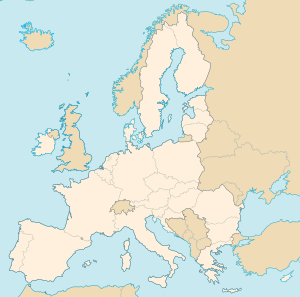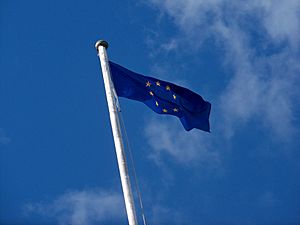European Union member state facts for kids
The European Union (EU) is a group of countries in Europe that work together. A European Union member state is a country that has joined this group. The EU started in 1958 as the European Economic Community (EEC) with just six countries. Over time, more countries joined, making the group bigger. The largest growth happened on May 1, 2004, when ten new countries joined at once.
The EU now has 27 member countries. When more countries join, it's called "enlargement" or "European integration." To join, a country must meet certain rules, known as the Copenhagen criteria. These rules mean a country must be a democracy, respect human rights, and follow the law. All current EU countries and the European Parliament must agree before a new country can join.
Bulgaria and Romania joined the EU on January 1, 2007. They signed an agreement called the Treaty of Accession in Luxembourg in 2005.
The United Kingdom used to be an EU member. It joined in 1973. On June 23, 2016, people in the UK voted to leave the EU. The country officially left the EU on January 31, 2020. This is why there are now 27 member states.

List of EU Countries
Current Members
| Flag | Country | Joined | Population | Capital City |
|---|---|---|---|---|
| Austria | January 1, 1995 | 8,169,929 | Vienna | |
| Belgium | March 25, 1957 | 10,274,595 | Brussels | |
| Bulgaria | January 1, 2007 | 7,679,290 | Sofia | |
| Croatia | July 1, 2013 | 4,290,612 | Zagreb | |
| Cyprus | May 1, 2004 | 835,000 | Nicosia | |
| Czechia | May 1, 2004 | 10,256,760 | Prague | |
| Denmark | January 1, 19732 | 5,368,854 | Copenhagen | |
| Estonia | May 1, 2004 | 1,415,681 | Tallinn | |
| Finland | January 1, 1995 | 5,157,537 | Helsinki | |
| France | March 25, 1957 | 59,765,983 | Paris | |
| Germany | March 25, 19571 | 83,251,851 | Berlin | |
| Greece | January 1, 1981 | 10,645,343 | Athens | |
| Hungary | May 1, 2004 | 10,075,034 | Budapest | |
| Ireland | January 1, 1973 | 4,234,925 | Dublin | |
| Italy | March 25, 1957 | 58,751,711 | Rome | |
| Latvia | May 1, 2004 | 2,366,515 | Riga | |
| Lithuania | May 1, 2004 | 3,382,041 | Vilnius | |
| Luxembourg | March 25, 1957 | 448,569 | Luxembourg | |
| Malta | May 1, 2004 | 397,499 | Valletta | |
| Netherlands | March 25, 1957 | 16,318,199 | Amsterdam | |
| Poland | May 1, 2004 | 38,625,478 | Warsaw | |
| Portugal | January 1, 1986 | 10,084,245 | Lisbon | |
| Romania | January 1, 2007 | 21,698,181 | Bucharest | |
| Slovakia | May 1, 2004 | 5,422,366 | Bratislava | |
| Slovenia | May 1, 2004 | 1,932,917 | Ljubljana | |
| Spain | January 1, 1986 | 44,708,964 | Madrid | |
| Sweden | January 1, 1995 | 9,090,113 | Stockholm |
1 On October 3, 1990, the former German Democratic Republic joined the Federal Republic of Germany, automatically becoming part of the EU.
2 Greenland left the Community in 1985.
Former Members
| Flag | Country | Joined | Left | Population | Capital City |
|---|---|---|---|---|---|
| United Kingdom | January 1, 1973 | January 31, 2020 | 60,201,000 | London |
Images for kids
-
A 2011 'family photo' of the European Council. This group includes the leaders of the member states, along with the President of the European Council and the President of the European Commission.
See also
 In Spanish: Estado miembro de la Unión Europea para niños
In Spanish: Estado miembro de la Unión Europea para niños




